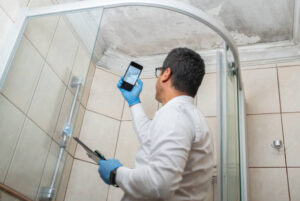
Damp and Mould: two of the most common problems in poorly maintained housing
The more people who can live a decent life by being kept out of fuel poverty and out of hospital, the better off the entire country is.
Take a look at this Headline: Tackling cold homes would save the NHS £540mn per year, new BRE research reveals
Here I examine the causes and health impacts of damp and mould and explore how education and retrofitting can help to eradicate these problems, particularly in low-income communities.
Causes of damp and mould
Damp and mould are caused by excess moisture in the home. This can come from a variety of sources, including:
- Leaking roofs, gutters, or pipes
- Rising damp from the ground
- Poor ventilation, particularly in kitchens and bathrooms
- Condensation on windows and walls
Once moisture enters the home, it can quickly create an environment that is hospitable to mould growth. Mould spores are ubiquitous in the air and can grow on any surface with enough moisture, including walls, ceilings, floors, and furniture.
The health impacts of damp and mould
Exposure to mould can trigger allergies, asthma attacks, and other respiratory problems. In extreme cases, it can even cause serious illnesses such as fungal infections and toxic reactions.
Young children have developing respiratory systems and are more susceptible to the effects of mould spores, while the elderly may already have compromised respiratory systems.
In addition to the direct health impacts, damp and mould can also contribute to poor mental health. Living in a damp and mouldy environment can be stressful and can lead to feelings of hopelessness and isolation.
Education as a key tool
Education is a key tool in the fight against damp and mould. By educating people about the causes and consequences of these problems, we can help them to take preventative steps.
Education can take many forms, including public awareness campaigns, community workshops, and targeted training for professionals such as landlords and housing inspectors.
Education can help people to identify the signs of damp and mould and take action before the problem becomes severe. This might include fixing leaky pipes or roofs, improving ventilation, or installing dehumidifiers.
Why retrofitting is necessary
While education is important, it is often not enough to solve the problem of damp and mould in existing housing stock. In many cases, retrofitting is required to address underlying structural problems and to improve ventilation and insulation.
Retrofitting can take many forms, depending on the specific needs of the building. It might include:
- Replacing leaky roofs or pipes
- Installing insulation to reduce heat loss and improve energy efficiency
- Upgrading ventilation systems to improve air quality and reduce humidity
- Installing damp-proof membranes to prevent rising damp
If you have the money to ventilate well (not just open a window) and heat the house to above 18 degrees - then damp and mould is rarely an issue.
However, if you live in a poorly insulated and difficult to heat property, and you cannot afford the bills – you have limited choices.

If you cook/wash/do laundry and - breathe… you generate more moisture (and statistically there is more overcrowding in poorer households as more people = more moisture).
What about private homes?
Statistically speaking, most homes below an EPC of E are in the private rental sector, which isn’t well regulated.
My thought process on improving the energy performance of privately rented homes is that we need split incentives to push this faster. A £10k capped grant would solve most/nearly all of the properties below C.
In this article the costs stated are sadly inaccurate – but E to C is doable at the £10-17k range. This is the scope/ambition of the national retrofit programme = £190 -250 billion over 10 years. That is, 25 billion per year now. For 2 million homes a year…? How many in PRS = 4.5MILLION.
10% of those in poverty live in the private rental sector, so we need to focus on the hard to reach first and not last. This will account for approximately 450,000 homes = £4.5 billion now to provide grants to PRS.
How residents feel
There is inferred blame on the residents, when it is often not solely their fault. There is also an immense frustration and sense of unfairness at the information they are sometimes provided by landlords about issues like condensation and mould.
"The Coroner’s ruling serves as a timely ‘wake-up call’ for the sector, which must endeavour to expand its understanding and awareness surrounding the impact to health of damp, condensation and mould in the home. This is particularly so in the context of the cost-of-living crisis, which will require landlords to make plans to tackle the risk of worsening damp and mould issues as energy bills rise. RPs (Registered Providers) could also now become responsible for mould, regardless of the cause. With the cost of energy increasing and the temptation by tenants to reduce the bills by not using appliances such as tumble dryers and keeping the windows closed to stay warm, the prospect of mould cases is likely to increase significantly, exposing tenants to an increased risk of harm and landlords to an increased risk of disrepair claims.”
To summarise…
Retrofit and good quality education would solve almost all of the building fabric issues. We need EPC C to be moved up the agenda NOW – its not just an energy efficiency thing: 2028 is too long to wait! Allowing private (and social) landlords the luxury of time to upgrade is wrongheaded thinking. The requirement now is that homes need to achieve EPC of E now (many do not even do that). Then they can wait till 2030 until they have to achieve a C.
My take on this is that all homes need to be at true C now.
- There need to be grants/retrofit workshops/incentives - but if these are not possible, then the alternative would be: compulsory purchase, fines, and not allowing properties to be rented out until they are improved.
- My prediction is that mould issues will vanish as houses become more energy efficient and are better able to deal with moisture. Maybe it will become part of a tenancy to have workshops on how to look after the home and deal with mould?
Carl Dodd, Property Revolutions Ltd.

